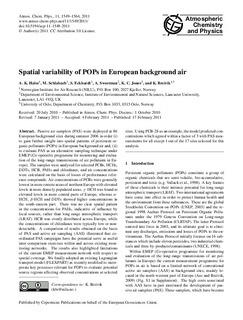| dc.contributor.author | Halse, Anne Karine | |
| dc.contributor.author | Schlabach, Martin | |
| dc.contributor.author | Eckhardt, Sabine | |
| dc.contributor.author | Sweetman, Andy | |
| dc.contributor.author | Jones, Kevin C | |
| dc.contributor.author | Breivik, Knut | |
| dc.date.accessioned | 2016-04-07T09:45:20Z | |
| dc.date.accessioned | 2016-04-19T10:21:21Z | |
| dc.date.available | 2016-04-07T09:45:20Z | |
| dc.date.available | 2016-04-19T10:21:21Z | |
| dc.date.issued | 2011 | |
| dc.identifier.citation | Halse, A. K., Schlabach, M., Eckhardt, S., Sweetman, A., Jones, K. C., Breivik, K. (2011) Spatial variability of POPs in European background air. Atmos. Chem. Phys., 11, 1549-1564. doi:10.5194/acp-11-1549-2011. | nb_NO |
| dc.identifier.issn | 1680-7324 | |
| dc.identifier.uri | http://hdl.handle.net/11250/2386212 | |
| dc.description.abstract | Passive air samplers (PAS) were deployed at 86 European background sites during summer 2006 in order (i) to gain further insight into spatial patterns of persistent organic pollutants (POPs) in European background air and, (ii) to evaluate PAS as an alternative sampling technique under EMEP (Co-operative programme for monitoring and evaluation of the long-range transmissions of air pollutants in Europe). The samples were analyzed for selected PCBs, HCHs, DDTs, HCB, PAHs and chlordanes, and air concentrations were calculated on the basis of losses of performance reference compounds. Air concentrations of PCBs were generally lowest in more remote areas of northern Europe with elevated levels in more densely populated areas. γ-HCH was found at elevated levels in more central parts of Europe, whereas α-HCH, β-HCH and DDTs showed higher concentrations in the south-eastern part. There was no clear spatial pattern in the concentrations for PAHs, indicative of influence by local sources, rather than long range atmospheric transport (LRAT). HCB was evenly distributed across Europe, while the concentrations of chlordanes were typically low or non-detectable. A comparison of results obtained on the basis of PAS and active air sampling (AAS) illustrated that coordinated PAS campaigns have the potential serve as useful inter-comparison exercises within and across existing monitoring networks. The results also highlighted limitations of the current EMEP measurement network with respect to spatial coverage. We finally adopted an existing Lagrangian transport model (FLEXPART) as recently modified to incorporate key processes relevant for POPs to evaluate potential source regions affecting observed concentrations at selected sites. Using PCB-28 as an example, the model predicted concentrations which agreed within a factor of 3 with PAS measurements for all except 1 out of the 17 sites selected for this analysis. | nb_NO |
| dc.language.iso | eng | nb_NO |
| dc.relation.uri | http://www.atmos-chem-phys.net/11/1549/2011/acp-11-1549-2011.pdf | |
| dc.rights | Navngivelse 3.0 Norge | * |
| dc.rights.uri | http://creativecommons.org/licenses/by/3.0/no/ | * |
| dc.subject | Zeppelinobservatoriet | |
| dc.title | Spatial variability of POPs in European background air | nb_NO |
| dc.type | Journal article | nb_NO |
| dc.type | Peer reviewed | nb_NO |
| dc.date.updated | 2016-04-07T09:45:20Z | |
| dc.source.pagenumber | 1549-1564 | nb_NO |
| dc.source.volume | 11 | nb_NO |
| dc.source.journal | Atmospheric Chemistry and Physics | nb_NO |
| dc.identifier.doi | 10.5194/acp-11-1549-2011 | |
| dc.identifier.cristin | 339165 | |
| dc.relation.project | Norges forskningsråd: 183437 | nb_NO |

